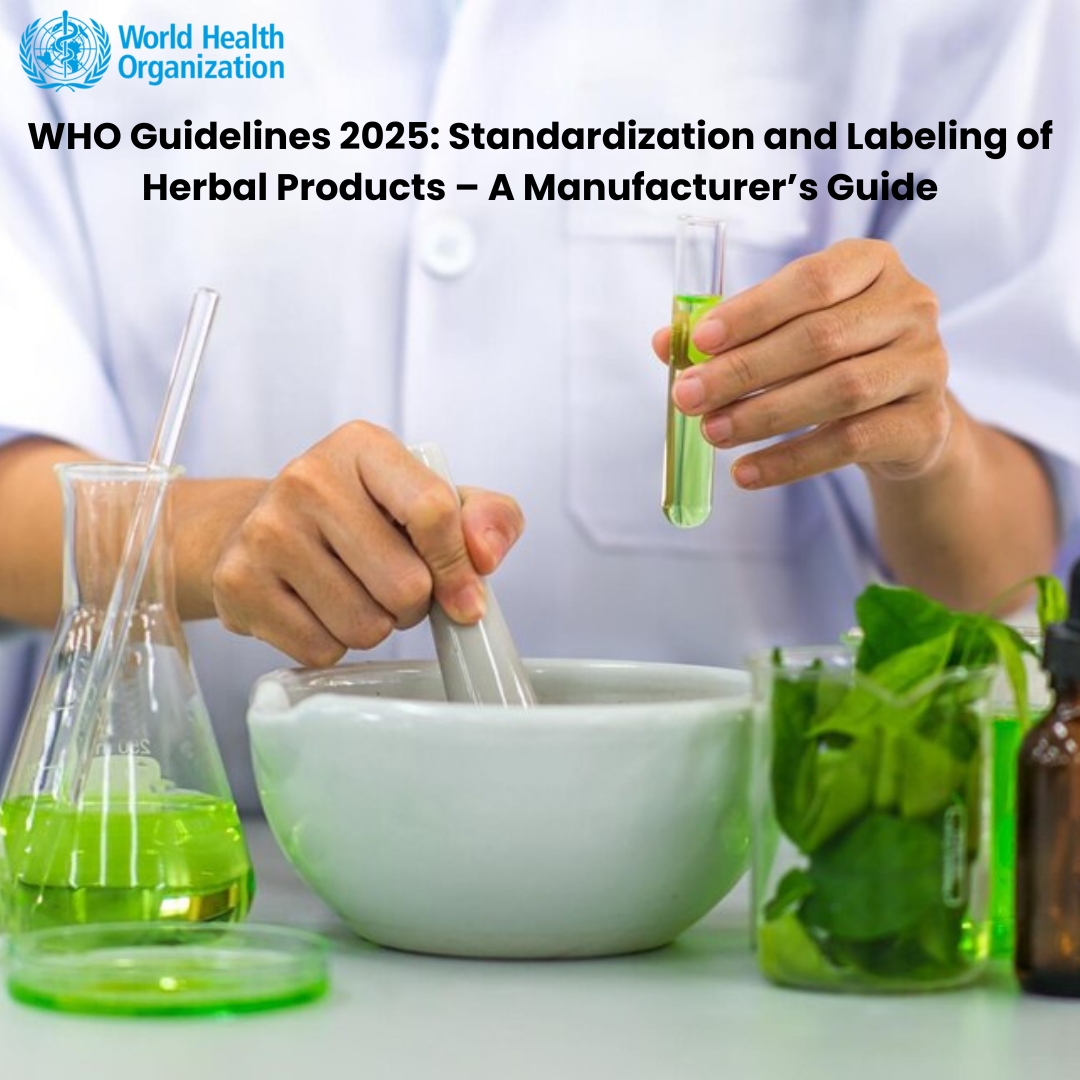5.WHO Labeling Requirements for Herbal Products
Labeling is an indispensable requirement in meeting herbal product compliance under WHO guidelines since it provides for safety, traceability, as well as informed use by consumers.

Medicinal plants have been one important part of global health care and, especially so, in the resource-limited settings. From the perspective of WHO, about 80% of the global population is dependent upon traditional medicine. However, standardization remains one of the bigger challenges, and especially with regards to phytochemical profiling and quality control, this affects international acceptance. The intention behind the 2025 WHO guidelines is to harmonize yet not standardize regulatory expectations through the life cycle of herbal productson safety, efficacy, and global market alignment. [1]
The guidelines intend to unify and standardize the protocols regarding the quality, safety, and efficacy evaluation of herbal products so that these products can be offered internationally in a form that is accepted by modern health care systems while respecting traditional medicine. Covering product development from raw materials to final labeling, the guidelines target individuals engaged in manufacturing, exporting, and the government; the ones who enforce and regulate the trade of herbal products.[2]
WHO emphasizes standardization for the safety, efficacy, and consistency of herbal products. The process begins with the identification of botanicals through macroscopic, microscopic, and molecular methods to avoid misidentification and adulteration. The raw materials must meet minimum quality criteria relating to moisture, foreign matter, and active constituents. This further ensures uniformity and therapeutic reliability across batches.
The extraction must be standardized and validated for the reliable extraction of the bioactive constituents. Analytical methods such as chromatographic fingerprinting can then be applied for their verification and study of stability. [3]
An example is DNA barcoding, which helps authenticate Panax ginseng species in dietary supplements.
Good Manufacturing Practices as per WHO are to be observed during manufacture, and the process should be validated, equipment calibrated, and work carried out by accredited personnel.
Quality control should be implemented throughout the production process and entail testing processes of drugs, including in-process and final product tests.
Stability testing evaluates the effects of storage conditions on product quality over time, assisting in determining shelf-life and storage recommendations. The final product must meet predefined standards regarding appearance, potency, purity, and microbial safety. Meeting these criteria will guarantee worldwide acceptance and consumer protection. [4]
| Parameter | Purpose | Common Tests/Techniques | Example Application |
| 3.1 Physicochemical Testing | Assess product consistency and chemical properties | pH, viscosity, solubility, HPLC, TLC | HPLC used to quantify curcumin in turmeric extracts |
| 3.2 Microbiological Testing | Ensure absence of harmful microorganisms | Total viable count, yeast & mold, E. coli, Salmonella | Microbial safety check for Echinacea tinctures |
| 3.3 Heavy Metal & Pesticide Limits | Verify compliance with safety limits for toxic residues | ICP-MS, AAS, chromatography for pesticide residue | Testing Ashwagandha root powder for arsenic levels |
| 3.4 Adulteration & Contaminants | Detect and prevent presence of non-declared or harmful substances | Visual inspection, spectroscopy, chemical markers | Identifying synthetic dyes in herbal teas labeled “natural” |
| 3.5 Chromatographic Fingerprinting | Confirm identity and quantify active compounds for standardization | TLC, HPLC, reference marker compounds | TLC fingerprinting to confirm sennosides in Senna leaves |
[Refer WHO good manufacturing practices for herbal medicines. In: WHO good manufacturing practices: Main principles for pharmaceutical products – Manufacture of herbal medicines, Annexure 2, Page 157 of 176, Section 3, Category 2, Under General Guidelines for Herbal Products, Sub-section (1) of Quality assurance in the manufacture of herbal medicines]
Good Manufacturing Practices (GMPs) of World Health Organization for herbal industries are the essential practices under which the facility design, validated processes, and quality control systems are defined in terms of maintaining product quality and safety. One of the most critical components found within the BMRs (batch manufacturing records), which documents every stage of production, makes regulatory compliance and traceability important. Source authentication is just as important, such as documenting the source and movement of material inputs within the supply chain. This combination brings value in terms of traceability by which contradictions can be detected, leading to better integrity of products. Maintenance of quality records and audit trail ensures effective monitoring, regulatory oversight, and overall transparency of processes.
[Refer WHO good manufacturing practices for herbal medicines. In: WHO good manufacturing practices: Main principles for pharmaceutical products – Manufacture of herbal medicines, Annexure 2, Page 157 of 176, Section 3, Category 2, Under General Guidelines for Herbal Products, Sub-section (1) Good manufacturing practice for herbal medicines]
Labeling is an indispensable requirement in meeting herbal product compliance under WHO guidelines since it provides for safety, traceability, as well as informed use by consumers.

According to WHO guidelines, the following components or elements of a label would ensure a clear and regulatory standardization:
Labels should display the manufacturer’s name, address, manufacturing license number, and country of origin, enhancing traceability and accountability.
Labels must clearly state known risks, allergenic potentials (e.g., “contains latex”), possible drug interactions, or contraindications (e.g., “Not recommended for pregnant women”).
The label should include the DOM and DOE in standard formats, such as MM/YYYY. The shelf life must be based on validated stability studies.
Each product must bear a batch or lot number that allows the whole traceability to its production records, quality testing, and raw materials origin. This number must correspond with the Batch Manufacturing Record (BMR) and test reports.
In addition to the basic universal labeling set up by WHO, manufacturers must also comply with national rules as be it the case in India with the AYUSH guidelines, or the EU Directive 2004/24/EC, or the U.S. FDA’s Dietary Supplement Health and Education Act (DSHEA).
[Refer Technical issues supporting good herbal processing practices in WHO guidelines on good herbal processing practices (GHPP) for herbal medicines, Annexure 1, Page 126 of 153, Section 5, Category 3, Under Technical Issues Supporting Good Herbal Processing Practices, Sub-section (5.2) Packaging and Labelling]
Mandatory Labeling Components According to WHO Guidelines
Component | Details/Requirement | Example |
Product Name | Commercial/trade name | “Herbal Digest-Ease” |
Botanical Name | Latin binomial & plant part | Curcuma longa L., rhizome |
Dosage Form | Capsule/Tincture/Powder | 500 mg capsule |
Manufacturer Info | Name, license, origin | XYZ Herbal Ltd., License No. 12345, India |
Warning | Contraindications or risks | “Not for use during pregnancy” |
Dates | DOM, DOE | MM/YYYY format |
Batch Number | Traceability link to BMR | Lot No: HL2024-03A |
Country Rules | Region-specific compliance | Follows AYUSH & DSHEA |
Only general well-being claims are allowed (e.g., “supports digestion,” “promotes relaxation”). These must be supported by scientific, ethnobotanical, or pharmacological evidence.
Claims such as “cures cancer” are prohibited unless backed by strong clinical data and approved by a regulatory authority. Disease-related claims without evidence are considered misleading.
Such claims must start with “traditionally used for” or “based on traditional practice” and must avoid implying definitive therapeutic benefits. Cultural and historical context should be clearly indicated.
All labeling and promotional claims must be evidence-based, culturally sensitive, and clearly distinct from pharmaceutical claims to prevent consumer confusion.[5]
Guidance is provided by WHO within the framework of national enforcement on safety, quality, and efficacy of herbal medicines. Harmonized monographs, GMP schemes, and labeling standards propagate these.
Region | Regulation |
EU | Traditional Herbal Medicinal Products Directive (THMPD) |
ASEAN | GMP Guidelines for Traditional Medicines |
India | Ministry of AYUSH and Ayurvedic Pharmacopoeia |
US | FDA regulation under DSHEA (Dietary Supplement Health and Education Act) |
WHO utilizes ISO 19609 for ensuring quality and tests methods, Codex Alimentarius for herbal food supplements, and ICH Q series guidelines for quality and stability testing. [6]
Testing Infrastructure Costly: High-tech equipment like HPTLC, GC-MS, and LC-MS/MS are costly and burdensome for SMEs.
Third-Party Labs Dependency: Small manufacturers are dependent on third-party labs, causing delays in testing and increasing operational costs.
Strategic Export Readiness: Approvals by WHO-GMP or ISO 22000, or USFDA allow easy access to world markets, generating credibility for the brand.
Concepts supported by WHO include:
This movement is now well aligned with the premium segment, enhancing consumer trust and pricing potential. [7]
SOPs should be elaborated on regarding each critical step: sourcing, processing, testing, and labeling. Templates should include QA/QC checklists, equipment logs, and deviation reports.
It is necessary to have Contact with the appropriate regulatory expert to comply with local and global standards. This is important for product registration, dossier submission, and third-party audits.
Not updating SOPs per regulatory changes [8]
Herbal standardization is a prerequisite for credibility, safety of medicines, and acceptance of herbal products worldwide. Such efforts in harmonization by WHO ultimately enable manufacturers to access safer international markets and increase consumer confidence. The successful manufacturers, therefore, move towards the development of a WHO-compliant brand by focusing on validated sourcing, robust documentation, transparent labeling, and, above all, science-based marketing of herbal products. Sustainability claims will also include responsible sourcing methods, community projects, eco-friendly packaging, and Good Agricultural and Collection Practices (GACP) adherence. Team up with Food Research Lab to add further value to sustainability and regulatory compliance through research assistance, sourcing ingredients, and developing green products.

Food Research Lab strives for excellence in new Food, Beverage and Nutraceutical Product Research and Development by offering cutting edge scientific analysis and expertise.
